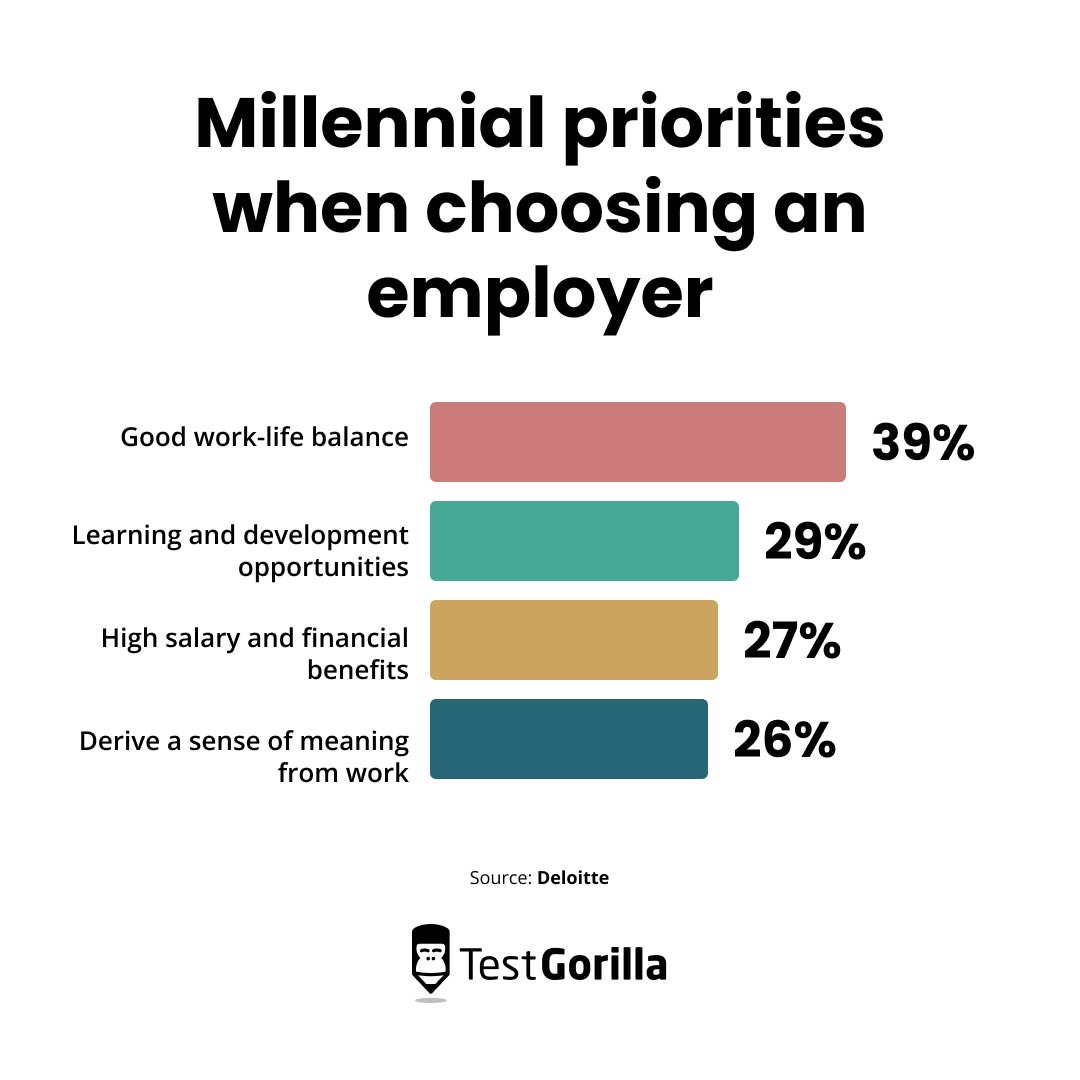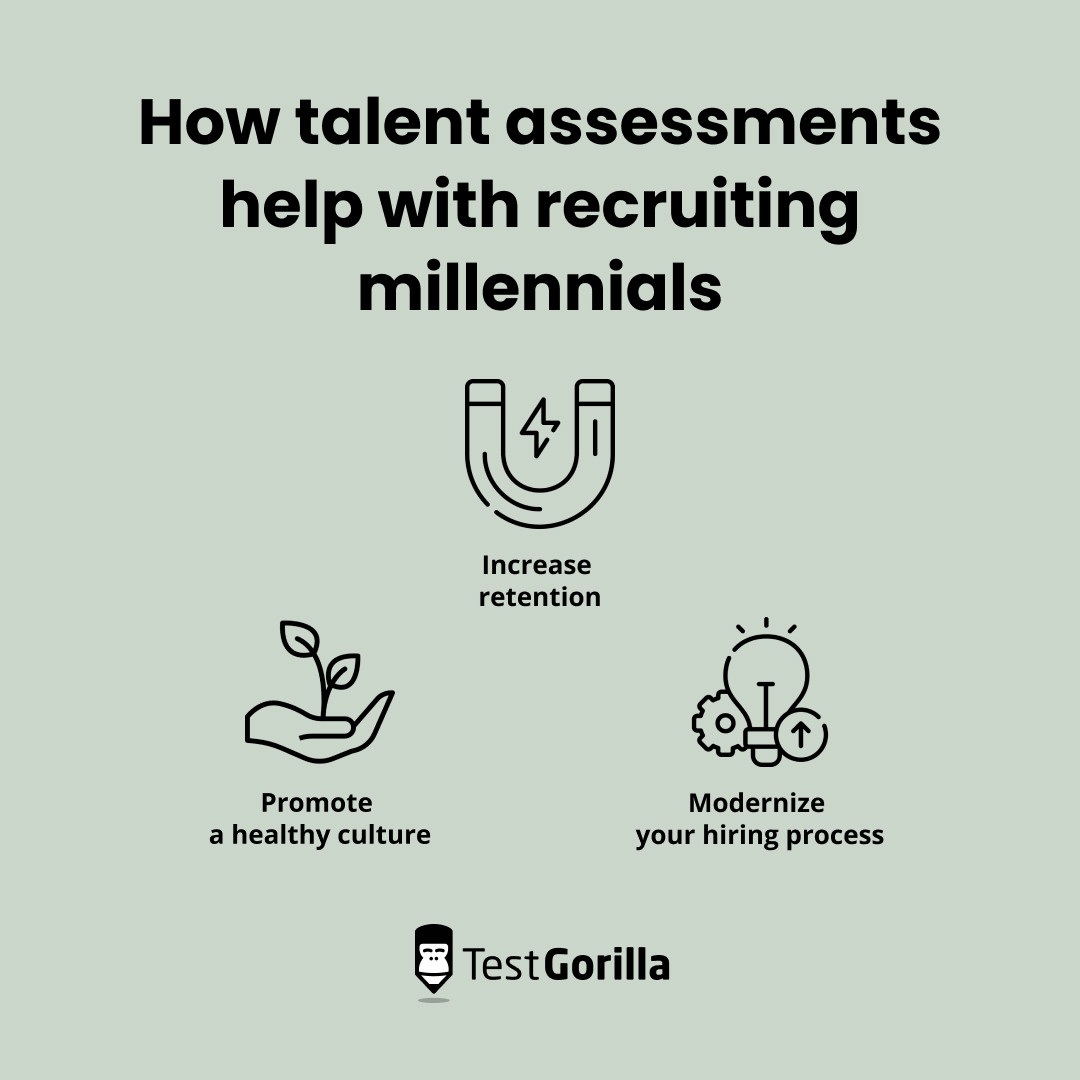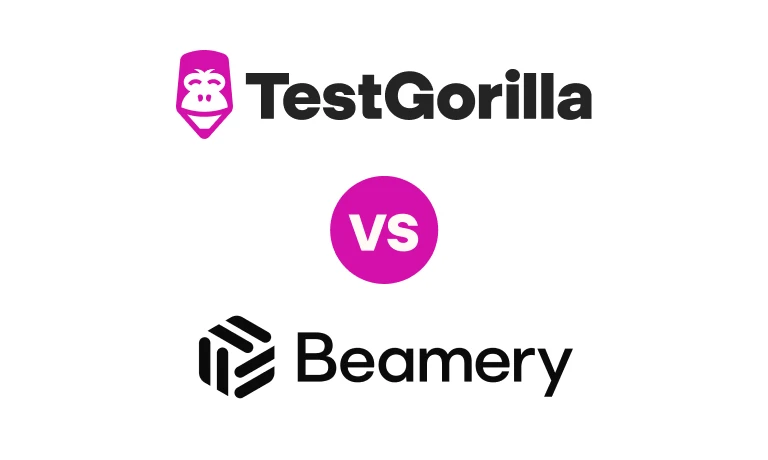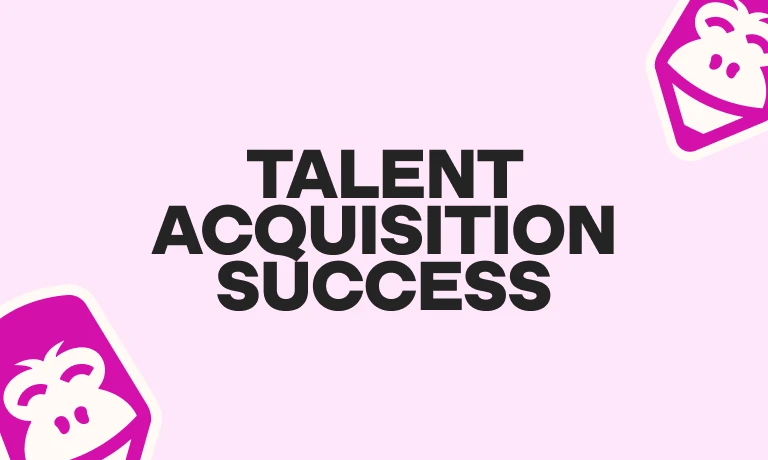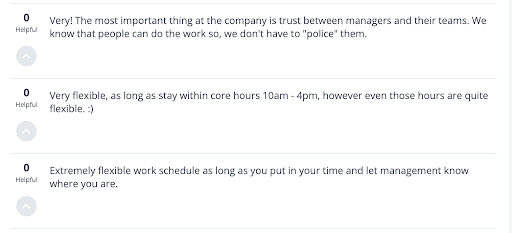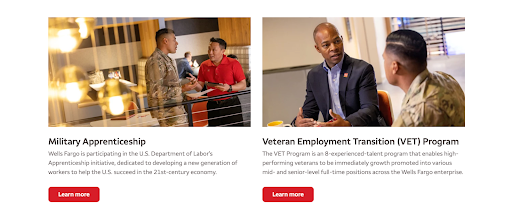Hiring millennials: How talent assessments help hire an independent and innovative workforce
Millennials are currently the largest working generation, representing 35% of the total US labor force.[1]
But the prevalence of millennial employees doesn’t mean they’re easy to hire.
In fact, this generation poses a series of unique challenges that traditional hiring practices aren’t equipped to handle.
Millennials’ desire for new technology in hiring, the freedom to explore different career paths, and transparency in their professional relationships requires an innovative recruiting strategy to fulfill these demands.
Talent assessments are a skills-based tool for hiring millennials and filling in-demand roles with quality candidates.
Whether you’re hiring an engineer with our Software Engineer test or assessing candidates’ communication skills, talent assessments are the key to hiring and retaining millennials.
In this article, we discuss what millennials are, the difficulties with hiring them, and how to hire millennials with talent assessments.
Table of contents
- What are millennials?
- The challenges of hiring millennials
- How talent assessments help with recruiting millennials
- 7 ways to use talent assessments to optimize hiring millennials
- Beyond talent assessments: 3 best practices to remember for hiring millennials in the workplace
- Meet millennials’ standards with talent assessments
What are millennials?
Millennials, born between 1981 and 1996, are independent thinkers who strive for employee wellbeing in their professional and personal lives.
They want the freedom to work flexibly and consistently to earn fair pay on their own schedules. But they also desire an emotional connection to the work they do every day.
In short, they want to be engaged at work, enjoy a healthy work-life balance, and work for organizations that have strong diversity, equity, and inclusion initiatives.
As many millennials came online in childhood and adolescence, they’re a hyper-connected generation that expects instant, easy access to information, communication, and work opportunities.
Research from Gallup backs this up: 71% of millennials say the internet is their main source of news and information.[2]
From this connectedness comes millennials’ desire for change in the world.
Whereas the baby boomer generation tends to pride themselves on hard work and independence to get ahead in life, millennials expect the organizations they work for to strive to make the world a better place, regardless of financial incentives.
Hiring millennials vs. Gen Z
If you have trouble distinguishing the characteristics, needs, and concerns of millennials and their generational successors Generation Z, you’re not alone.
Many organizations miss the subtle but significant differences between hiring millennials and hiring Gen Z.
Millennials and Gen Z’s generational diversity appears in several categories:
Decision-making: The millennial generation is the first to be worse off financially than their parents yet still tends to have an optimistic, entrepreneurial spirit. Gen Zers, on the other hand, gravitate toward proven methods for success and are cautious in their decision-making.
Collaboration: Although millennials like to blaze their own paths, they value teamwork and collaboration more than Gen Z, who prefer to figure things out themselves and maintain control of their futures.
Motivation: Millennials’ commitment to teamwork and connection motivates them to serve a social good in their work, and they expect their employers to do the same. Gen Z is also socially engaged, but they tend to value career progression and financial security as key motivators.
Career path: Millennials are not accustomed to a single, steady career path. When they’re disengaged at work, they don’t hesitate to find a new job or switch careers entirely. Gen Z prefers to use their job as a launchpad to learn everything they can about a company in the hopes of sticking to a linear career path.
The importance and benefits of hiring millennials
Millennials’ characteristics and motivators are also what make them valuable additions to your workforce.
It’s important for businesses to learn how to recruit millennials because they:
Promote a positive company image: Millennials’ commitment to social justice and diversity infuses the language, action, and branding of the organizations they work for. In other words, they are equipped to promote a positive image of your company to prove your commitment to making the world a better place.
Believe in your mission: If a millennial decides to join your organization, there’s a strong chance they believe in your corporate purpose. They will work hard to achieve organizational goals because they trust the value they generate will positively impact others.
Are adaptable: Millennials grew up in an era defined by social, environmental, and economic change. Although these obstacles have made their future success a bit cloudier than previous generations, they have also made millennials flexible and unafraid to perform in the face of uncertainty.
Think and work creatively: Millennials’ computer literacy, fierce independence, and innovative spirit enable them to approach challenges creatively. They also value ethnic, racial, and gender diversity in the workplace because they seek creative and innovative teams.
The challenges of hiring millennials
Many companies are asking how to hire and retain millennials.
Although millennials offer many benefits to your organization, accessing these benefits can be difficult without a strong talent acquisition strategy.
Gone are the days when an employer could expect job seekers to send out torrents of resumes, sit through endless rounds of interviews, and settle for subpar wages and working conditions.
Let’s take a closer look at the main hiring challenges businesses face when recruiting millennials.
Millennial job-hoppers
Millennials are often unfairly labeled lazy, distracted, and difficult to satisfy.
This is a generalization, but many millennials tend to leave roles that are unengaging or do not align with their passions and motivations.
Organizations with toxic company cultures, poor organizational planning, and insufficient employee training and development opportunities struggle to hire millennials who commit for the long term.
In fact, research from Gallup shows that 21% of millennials say they’ve changed jobs within the past year, a rate more than three times other generations. This retention challenge costs the US economy $30.5bn annually.
Traditional hiring processes don’t work
Using a hiring process that worked for older generations, like baby boomers and Gen X, doesn't necessarily work for millennials.
Specifically, organizations that perpetuate degree inflation, resume requirements, and a fixation on past work experience are unlikely to be successful in hiring a millennial workforce.
That’s because millennials want the opportunity to show off their skills, abilities, and ideas in the hiring process – not jump through arbitrary hoops that rarely predict performance.
Following outdated, inefficient application processes costs you top talent: Around 50% of millennials would consider turning down a job offer due to a complicated hiring process or discrepancies between the job description and interview.
When you test their skills, you solve both these issues with a straightforward vetting process that sets clear expectations of the skills needed for the job they’re applying to.
Employers need to offer more than money
Businesses planning to hire millennials without paying a fair wage are in for a rude awakening.
When it comes to choosing an employer, a survey from Deloitte found millennials prioritize other factors when choosing an employer:
Good work-life balance (39%)
Learning and development opportunities (29%)
High salary and financial benefits (27%)
Derive a sense of meaning from work (26%)
Instead, organizations that want to secure millennial talent need to focus on fair wages and fostering an engaging, flexible, and socially conscious workplace culture.
Millennials’ entrepreneurial spirit
Millennials consistently show more enthusiasm for creating and managing their own businesses than their generational predecessors.
Instead of asking to work for your organization, millennials ask: “Why don’t I work for myself?”
It’s no surprise millennials are becoming the freelancer generation. In 2022, 46% of millennials performed freelance work.
Organizations need to:
Find ways to cater to millennials’ desire for autonomy in their roles
Improve their processes for hiring contractors and supporting them next to their traditional workforce
Make a strong case for why an outside business can leverage and support their entrepreneurial spirit
The best insights on HR and recruitment, delivered to your inbox.
Biweekly updates. No spam. Unsubscribe any time.
How talent assessments help with recruiting millennials
Talent assessments – like multi-measure skills, personality, and situational judgment tests – are powerful tools to attract and hire millennial workers.
Why?
Because they meet millennials’ demands and expectations while offering employers hard data about their ability to actually do the job.
Let’s discuss the ways talent assessments help recruit millennials.
Increase retention
Our State of Skills-Based Hiring 2022 report found that 91.2% of organizations using skills-based hiring saw an increase in employee retention.
Pre-employment talent assessments play a pivotal role in employee retention because they give millennial candidates a platform to show their skills and abilities.
Remember, millennials rarely feel the need to impress their employers. They want to see whether an organization is fit to leverage and value their skills for the long term.
Otherwise, job-hopping is always an attractive option for this generation, and you’ll be left struggling to fill the openings left by millennials leaving.
Promote a healthy culture
Talent assessments give employers an opportunity to promote their healthy workplace culture from the beginning of the hiring process.
Instead of asking millennial candidates for their educational background, talent assessments ask candidates to complete role-specific tasks, describe their thought processes and cognitive abilities, and navigate job-related scenarios.
This signals to candidates that your culture is geared toward:
Leveraging and developing skills
Approaching problems with logic and reason
Using teamwork and communication to overcome challenges
Modernize your hiring process
Tech-savvy millennials appreciate new technology and innovative solutions to problems.
TestGorilla’s report also found that 53.4% of respondents believe skills-based hiring will be the dominant hiring method in the future.
Not only is skills-based hiring the future of employment – talent assessments also give millennial applicants the candidate experience they crave because they rely on subject matter experts’ knowledge of the topic.
TestGorilla’s library of talent assessments, for example, also lets employers create and use their own unique tests.
So, as a company’s millennial talent pool continues to evolve, its hiring needs do too.
7 ways to use talent assessments to optimize hiring millennials
Talent assessments are an asset to any organization in need of recruiting techniques for hiring millennials.
They’re easy to use, informative about a company’s expectations and a role’s responsibilities, and give millennials what they want – an opportunity to prove they have what it takes to succeed in your company.
Below, we deep dive into seven practical ways to implement talent assessments and improve your millennial recruitment process.
7 ways talent assessments optimize millennial recruitment | How it works |
1. Promote new technology | Leverage accessible, easy-to-use assessment platforms to attract millennial talent |
2. Ensure transparency | Use role-specific skills tests so candidates know what to expect if hired |
3. Offer upskilling opportunities | Provide practical, hands-on experience with skills tests and training programs |
4. Find skills beyond degrees | Eliminate degree and resume requirements to widen the talent pool and mitigate bias |
5. Evaluate culture add | Use culture add tests to learn how a candidate can improve your existing culture |
6. Encourage feedback | After candidates complete your assessments, ask for their feedback to learn about their motivations and perspectives |
7. Reduce time-to-hire | Streamline the hiring process with talent assessments to show candidates you respect their time and effort |
1. Promote new technology
Using talent assessments in your hiring process is a great first step to showing millennial candidates that your business isn’t afraid to use new technology to fill roles.
That’s because the assessments are themselves a relatively new form of technology.
But they also show your millennial talent pool that you are aware of and know how to adopt and leverage new technology to improve individual and organizational performance.
TestGorilla’s Selenium with Python test, for example, evaluates candidates’ ability to automate browser activities using Selenium’s innovative WebDriver architecture.
Instead of asking basic programmer questions, this test focuses on how automated tester candidates use Python programming language to accomplish complex tasks.
2. Ensure transparency with role-specific talent assessments
Millennials value transparency in hiring. They want to know exactly what they’re getting into when they apply for a job.
Talent assessments set clear expectations for what the job entails, like the skills needed to succeed and the projects they’ll be working on if hired.
Technical skills tests, for example, evaluate candidates’ knowledge and experience working with certain tools and concepts so your millennials don’t feel blindsided when they join your organization.
Personality tests give candidates an opportunity to learn more about how their behavior, motivation, and personality traits influence their personal and professional relationships.
When they enter your workforce, they’ll have an idea about the type of role they’re best suited for and the conditions they prefer to work under.
Role-specific skills tests ensure transparency by asking questions candidates need to know the answers to if they’re going to succeed in their role.
TestGorilla’s Legal Assistant (US) Online test, for example, evaluates candidates’ skills related to specific tasks:
Intakes
Filings and preparations
Client management
Professionalism
3. Offer upskilling opportunities
Nearly three-quarters of Gen Z and millennials are ready to leave their jobs if they don’t get adequate career mobility or upskilling opportunities.[3]
An example of offering skills development is Verizon’s Skill Forward program, which has free technical and soft skills training to develop workers for careers in technology.[4]
These fully online programs offer practical, hands-on learning experiences through skills tests and training courses in fields like cybersecurity, IT support, and digital marketing.
With 42% of Verizon’s workforce represented by millennials and Gen Z, their upskilling opportunities are making a positive impact on their talent acquisition.[5]
Skills tests are also useful tools to identify areas of improvement for candidates and existing employees – an integral part of learning and development that millennial workers expect from employers.
4. Find skills beyond degrees
Multi-measure talent assessments identify candidates’ hard and soft skills, regardless of whether they went to college.
They also overcome unconscious bias in hiring caused by degree requirements.
In this case, bias refers to organizations and hiring managers’ tendency to advance candidates with formal education backgrounds without actually discerning their skills and abilities.
Use talent assessments to expand your talent pool with STARs, for example, who have gained in-demand skills outside the now-expected path of college education through:
Workforce training
Volunteer work
Certification programs
Military service
Personal interests
Eliminating degrees is a driver of diversity hiring that boosts innovation, creativity, and productivity in the workplace – all key characteristics of the millennial workforce.
Everyone benefits: Employers gain skilled, high-potential talent, and millennials are empowered and rewarded for their unique skills, backgrounds, and perspectives.
Okta, a company that provides tools to securely access business applications, did away with its degree requirements to access a wider talent pool. The results?
Okta was ranked one of the 100 best workplaces for millennials in 2020.[6]
5. Evaluate millennials’ culture add
As mentioned earlier, culture matters to millennials – and not only your existing culture.
Millennials want to work for organizations that aren’t stuck in groupthink quagmires or that pat themselves on the back for doing the bare minimum to maintain a positive workplace culture.
Culture add talent assessments show your millennial candidates that your business values a strong company culture and is looking to develop its culture with new hires.
TestGorilla’s Culture Add test, for example, assesses how well candidates align with your culture and values while tracking their potential to improve it.
6. Encourage feedback and share results
Talent assessments give you valuable data about your millennial candidates’ skills, personality, and culture add.
But they are also a great way to learn your candidates’ perspectives, worldviews, motivations, and thoughts about your hiring process.
Millennials value clear and consistent workplace communication. Pre-employment talent assessments encourage and facilitate healthy communication from the beginning of the employee life cycle.
Encouraging feedback on talent assessments is a win-win for your organization: Candidates feel comfortable communicating their opinions about your hiring process and their career goals, and your organization learns where the process needs to improve.
Consider sharing the results of your talent assessments with your millennial candidates to get the most out of your talent acquisition strategy.
7. Reduce time-to-hire
Although millennials are a bit more patient when it comes to time-to-hire than their digital native successors (Gen Z), reducing time-to-hire is crucial to convincing millennials that you are worth their time and effort.
Skills-based hiring practices that include multi-measure talent assessments have a positive impact on hiring speed because they cut out candidates’ time spent writing and sending resumes or sitting through rounds of interviews.
TestGorilla’s Retail Sales test, for example, is a role-specific skills test that only takes ten minutes to complete.
Beyond talent assessments: 3 best practices to remember for hiring millennials in the workplace
Talent assessments are a proven method to secure skilled millennial talent.
But they’re not the only way to meet millennials’ demands and fill your organization with the right employees.
Let’s explore three other best practices to remember when hiring millennials.
3 best practices beyond talent assessments | How it works |
1. Provide flexible work options | Offer hybrid and remote work opportunities to show your commitment to flexibility in the workplace |
2. Stand behind your vision | Define and communicate the role that your organization plays in the wider world |
3. Create a strong career pathing program | Take an active role in employees’ development at every stage of the employee life cycle |
1. Provide flexible work options
Emphasizing flexibility in the workplace is key to attracting millennials.
With nearly three-quarters of millennials saying their career growth benefited from hybrid work environments, employers need to make flexibility a priority and improve their ability to hire remote workers.[7]
By offering remote or hybrid work opportunities wherever possible, you show candidates that you:
Have a company culture that values outputs over inputs
Are committed to making their working conditions as flexible as possible
Microsoft, for example, consistently offers flexible work opportunities for junior, middle, and senior-level positions.
Microsoft employees are also quick to give their feedback about workplace flexibility:
With 73% of millennials reporting they are satisfied with their work-life balance at the company, the evidence is clear: Flexibility is king when it comes to millennials.[8]
2. Stand behind your vision and voice
In addition to talent assessments, make sure to articulate your employer brand and vision – not only on your job descriptions but also in the way you run your business.
Forrester reported that four out of five millennials prefer a company with a strong vision and voice.[9]
Millennials aren’t easily swayed by lip service and virtue-signaling.
They want to know your organization's precise role in the wider world and your goals beyond profit.
Standing behind your vision and voice means answering these questions and showing long-term commitment to social, environmental, and economic progress.
Take tangible steps to improve your organization’s relationship with its employees, shareholders, and the communities it operates within.
3. Create a strong career pathing program
Building a strong career pathing program is also a great way to cater to millennials’ desire to develop and advance in their professional lives.
Wells Fargo’s military veteran programs are a great example of how an organization can take a meaningful role in an individual’s career development.
With 82% of the US military comprised of millennials, Wells Fargo is leading the charge to develop talented millennials with transferable skills.[10]
Meet millennials’ standards with talent assessments
Millennials are a creative, independent, and resilient generational cohort that provides value to organizations in every industry.
However, they’re not the easiest to hire.
Organizations have to live up to millennials’ standards not only to simply fill openings but also to secure talent that will sustain their businesses in the future.
Talent assessments speak the millennial language of hiring efficiency, autonomy, and development to quickly engage and recruit millennial candidates.
Make sure your talent assessments provide transparency, embody your organizational culture, and offer plenty of opportunities for candidate feedback.
Explore our extensive test library of 300+ talent assessments to gain new tools to hire millennial workers.
Sources
1. Fry, Richard. (April 11, 2018). “Millennials are the largest generation in the U.S. labor force”. Pew Research Center. Retrieved August 22, 2023. https://www.pewresearch.org/short-reads/2018/04/11/millennials-largest-generation-us-labor-force/
2. Adkins, Amy. (May 10, 2016). “What Millennials Want From Work and Life”. Gallup. Retrieved August 22, 2023. https://www.gallup.com/workplace/236477/millennials-work-life.aspx
3. “Upskilling Study”. (October 27, 2022). Workplace Intelligence. Retrieved August 29, 2023. http://workplaceintelligence.com/upskilling-study/
4. “Verizon Skill Forward”. Verizon. Retrieved August 22, 2023. https://www.verizon.com/about/responsibility/human-prosperity/reskilling-program
5. “Verizon Communications Demographics and Statistics”. Zippia. Retrieved August 22, 2023. https://www.zippia.com/verizon-careers-12380/demographics/
6. “2020 Best Workplaces for Millennials: Okta, Inc”. Fortune. Retrieved August 22, 2023. https://fortune.com/ranking/best-workplaces-millennials/2020/okta/
7. Kelly, Jack. (June 7, 2022). “What Different Generations Think About Hybrid Work”. Forbes. Retrieved August 22, 2023. https://www.forbes.com/sites/jackkelly/2022/06/07/what-different-generations-think-about-hybrid-work/
8. “Millennials at Microsoft”. Comparably. Retrieved August 22, 2023. https://www.comparably.com/companies/microsoft/millennials
9. Ramos, Laura. (February 19, 2020). “Millennials Want Credible Digital Content — So Give It To Them!”. Forrester. Retrieved August 22, 2023. https://www.forrester.com/blogs/millennials-want-credible-digital-content-so-give-it-to-them/
10. Trent, Kanessa. (November 2019). “Motivating and Educating Millennials”. Army University Press. Retrieved August 22, 2023. https://www.armyupress.army.mil/journals/military-review/english-edition-archives/november-december-2019/trent-educating-millennials/
You've scrolled this far
Why not try TestGorilla for free, and see what happens when you put skills first.


